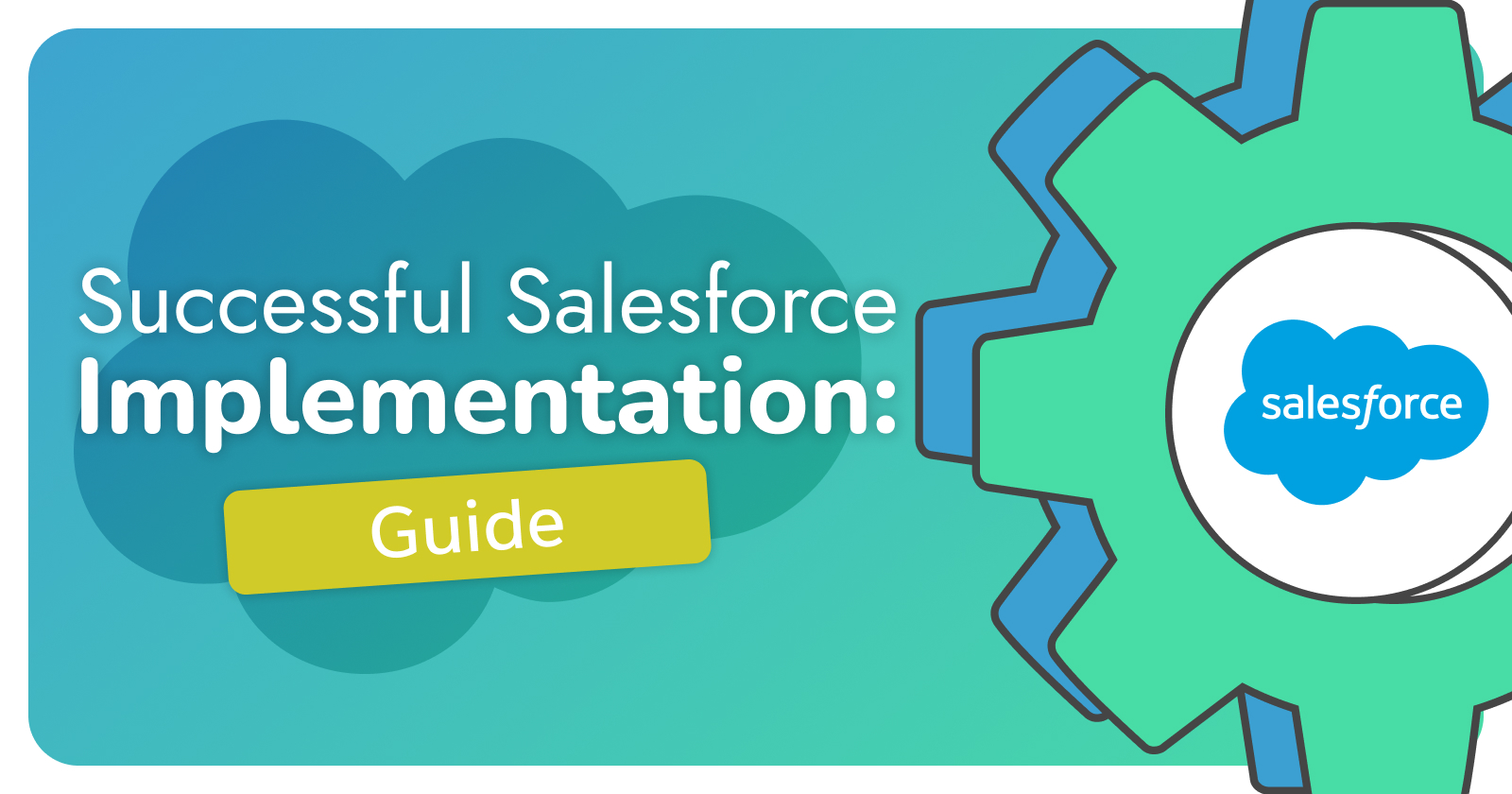Successful Salesforce Implementation: Guide
 Pavel Klachkou
Pavel Klachkou
Salesforce Implementation can transform business growth and productivity. However, without careful planning and execution, projects risk delays, cost overruns, and limited user adoption.
This guide shares best practices culled from real-world experience with Salesforce Implementation Services for organizations of all sizes and industries. Follow these steps and recommendations to ensure your deployment delivers maximum value.
Set Clear Business Goals
The first step is aligning stakeholders on primary objectives. Common goals include:
🧩 Increase sales revenue and pipeline visibility
🧩 Improve marketing campaign performance
🧩 Streamline customer support workflows
🧩 Gain a “360 view” of customer interactions
With clear goals set, it’s easier to chart the path to success and measure outcomes. These guiding metrics justify the investment and focus teams. Revisit initially defined goals frequently as measures of project progress.
Audit Current Business Processes
Gaining an accurate understanding of existing workflows, pain points, and data challenges is vital for shaping effective solutions.
Key activities:
⚙️ Document lead-to-cash, service request routing, or other critical funnels.
⚙️ Identify friction points - Note manual hand-offs, productivity bottlenecks, and information gaps hindering operations.
⚙️ Interview team members - Get perspectives from sales, service agents, and other key personnel on their daily challenges.
⚙️ Take an inventory of existing data - Catalog formats, repositories, completeness, and governance approach across systems.
Treat this audit as an opportunity to reimagine processes, not just replicate broken models.
Create an Implementation Roadmap
With goals and current-state analysis complete, the project manager can chart a course for meeting objectives via Salesforce capabilities.
Essential components within an implementation roadmap include:
📲 Roles and responsibilities - Identify key players like executive sponsors, admins, project team members, and user leads.
📲 Project phases - Break initiatives into logical chunks like discovery, configuration, testing, and training.
📲 Milestones - Define go/no-go decision points to measure progress like process design signoff or staged rollouts after UAT.
📲 Budget and timeline - Estimate effort, costs, and timing across resources, licenses, customizations, data migration, and integrations.
📲 Risk management - Document potential implementation obstacles and mitigation plans like shifting responsibilities or addressing change resistance.
📲 Communication Plan - Determine scheduled touchpoints to update leadership, users, and other stakeholders throughout the project.
Revisit and update the roadmap frequently as the fluid nature of projects requires adaption.
Foster Adoption with Change Management
The most robust Salesforce implementation can still fail without proper organizational change management. Proactively get ahead of known adoption barriers like:
🚩 Lack of visibility into project progress - Increase awareness through newsletter updates, FAQs, and word-of-mouth enthusiasm from project members.
🚩 Assumptions that legacy processes transfer automatically - Set expectations that change is required to achieve defined goals.
🚩 Perceived complexity due to unfamiliar features - Simplify messaging and provide hands-on walkthroughs tailored to user roles.
🚩 Hesitancy to move from current tools and workflows - Incentivize technology adoption tied to performance metrics.
Getting team buy-in at all levels ensures you guide colleagues successfully from initiative launch through sustained utilization.
Maintain Momentum Post-Launch
Salesforce projects don’t end at the go-live date. To continually grow and optimize value, keep these steps top of mind:
✅ Define long-term ownership - Maintain clear delineations between the ongoing responsibilities of administrators, project sponsors, and support resources.
✅ Conduct periodic success reviews - Measure key performance indicators against baseline metrics to showcase ROI and areas for improvement.
✅ Develop an enhancement pipeline - Using stakeholder feedback and solution expertise, continually add new features and workarounds that maximize efficiency.
✅ Evaluate integration opportunities - Connect related applications like e-commerce platforms, marketing suites, and ERP tools for end-to-end process continuity.
Making these success measures habitual cement Salesforce as a pivotal component in empowering teams long-term.
Choose the Right Edition and Licenses
Selecting the Salesforce edition and number of licenses that align with current and future user needs is key. Factor in departmental requirements and growth plans across these core considerations:
🧩 Number of sales, service, marketing, and admin personnel needing access
🧩 Advanced capabilities like AI, custom reporting, or e-commerce
🧩 IT infrastructure limitations ruling out Lightning capabilities
🧩 Budget availability over multi-year horizons
Misaligned edition selection and license volume risk feature gaps or access bottlenecks that limit adoption.
Set Realistic Expectations Around Customizations
While Salesforce provides abundant configuration options via point-and-click wizards and drag-and-drop simplicity, additional customizations often prove alluring. However, bespoke personalizations can complicate upgrading platforms down the road.
Take a measured approach when evaluating the build vs. buy tradeoff:
⚙️ Leverage AppExchange offerings to efficiently fill common gaps
⚙️ Analyze the total cost of ownership for maintaining custom tools
⚙️ Map integrations to simplify deep platform connectivity
While personalized touches can optimize workflows, resist over-customizing for marginal gains unlikely to prove worthwhile long-term.
Develop Clear Data Migration Strategies
Centralizing dispersed customer data from legacy systems into Salesforce unlocks insights through reporting dashboards. However, without organizing principles for data consolidation, misaligned formats and definitions create confusion.
📲 Catalog all source systems with current data types, access protocols, and completeness
📲 Define common language for uses like account, contact, and lead record merging
📲 Develop extract-transform-load (ETL) processes for seamless data movement
Poor data hygiene drags productivity and decision-making. Develop precise targeting rules and proactive cleansing flows for analytics-ready information.
Conclusion
Approaching Salesforce implementation with a methodical, milestone-driven strategy based on defined operational goals gives the best chance for outcomes that exceed KPIs. But it also requires vigilant change management and continual enhancement well after launch.
While each company's business objectives shape unique solutions, following the guidelines above provides a flexible framework adaptable across use cases to help avoid missteps. Documented processes and automated workflows may require refactoring but augmenting them with data-driven insights delivers tangible dividends.
Remember, Salesforce projects aren't "one and done." Treat the implementation as an evolving platform enabling teams to achieve more together over time. With the right vision and plan, transformative productivity growth lies ahead.
Subscribe to my newsletter
Read articles from Pavel Klachkou directly inside your inbox. Subscribe to the newsletter, and don't miss out.
Written by

Pavel Klachkou
Pavel Klachkou
Greetings! I'm Pavel Klachkou, the CTO and Founder of Routine Automation, where we specialize in crafting sophisticated and effective solutions for Salesforce enhancement. With a career spanning over a decade, my commitment to creating scalable solutions that seamlessly align with business objectives has been the driving force behind Routine Automation since its establishment in 2019. In my role as CTO, I lead high-performing teams, emphasizing innovation, efficient resource allocation, and timely project delivery. Before founding Routine Automation, my expertise in Salesforce solutions was honed as a self-employed Salesforce Tech Lead & Architect, where I meticulously designed and implemented scalable architectures. My journey in technology began with Microsoft Dynamics AX, where I dedicated over a year to implementing solutions. Today, as the CTO and Founder of Routine Automation, I continue to blend technological prowess with strategic vision, ensuring our projects set the standard for excellence. Join me on this journey as we navigate the intricacies of cutting-edge technology and deliver impactful solutions at Routine Automation – where expertise meets innovation.